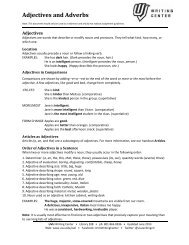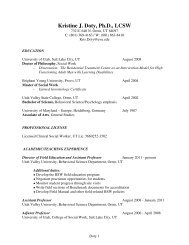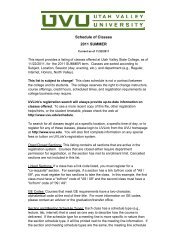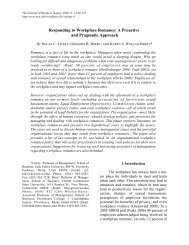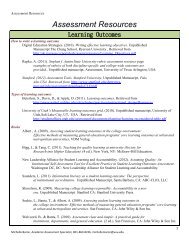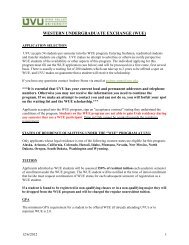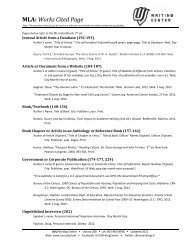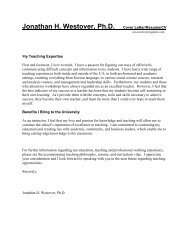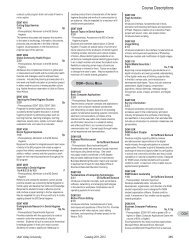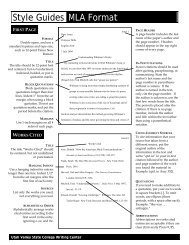Using Case Studies to Develop Critical Thinking Skills in ... - uvu.edu
Using Case Studies to Develop Critical Thinking Skills in ... - uvu.edu
Using Case Studies to Develop Critical Thinking Skills in ... - uvu.edu
- No tags were found...
Create successful ePaper yourself
Turn your PDF publications into a flip-book with our unique Google optimized e-Paper software.
USING CASE STUDIES TO DEVELOP CRITICAL THINK-ING SKILLS IN ETHICS COURSES 1Robert F. CardState University of New York, OswegoINTRODUCTION AND OVERVIEWThe focus of this paper will be on techniques for gett<strong>in</strong>g the mostfrom case studies <strong>in</strong>tended <strong>to</strong> <strong>in</strong>troduce critical th<strong>in</strong>k<strong>in</strong>g skills <strong>in</strong> ethicscourses. The ma<strong>in</strong> po<strong>in</strong>t is that <strong>in</strong>corporat<strong>in</strong>g case studies is an essentialelement <strong>in</strong> teach<strong>in</strong>g ethics, s<strong>in</strong>ce the primary goal of this endeavor is <strong>to</strong><strong>in</strong>culcate critical th<strong>in</strong>k<strong>in</strong>g skills and cases are an undervalued <strong>to</strong>ol fordevelop<strong>in</strong>g analytical capacities <strong>in</strong> students. In this paper, I do not purport<strong>to</strong> defend a metaethical approach <strong>to</strong> case studies, but <strong>in</strong>stead addressthe <strong>to</strong>pic strictly from the perspective of pedagogy.I will illustrate these techniques and methods by demonstration <strong>in</strong> adiscussion of two bioethics cases concern<strong>in</strong>g reproductive technology.These cases were selected s<strong>in</strong>ce they br<strong>in</strong>g <strong>in</strong><strong>to</strong> focus theoretical po<strong>in</strong>tsconcern<strong>in</strong>g ethics that students often have a difficult time understand<strong>in</strong>g<strong>in</strong> other contexts. By <strong>in</strong>troduc<strong>in</strong>g these <strong>to</strong>pics with a case study, studentsmore easily apply critical th<strong>in</strong>k<strong>in</strong>g skills <strong>to</strong> the relevant theoretical po<strong>in</strong>tsby ty<strong>in</strong>g their reason<strong>in</strong>g <strong>to</strong> elements of the scenario. In addition, the casestudies not only serve as applications of ethical theories, but also serve <strong>to</strong>highlight important philosophical issues concern<strong>in</strong>g ethical theoriesthemselves. I will beg<strong>in</strong> by briefly discuss<strong>in</strong>g the nature of ethics as I seeit <strong>in</strong> order <strong>to</strong> illustrate how the ethical enterprise dovetails with the goalof promot<strong>in</strong>g critical th<strong>in</strong>k<strong>in</strong>g skills by us<strong>in</strong>g case studies <strong>in</strong> ethicscourses.THE NATURE OF ETHICSStudents often suffer from a number of preconceptions and misconceptionsconcern<strong>in</strong>g the nature of ethics. Some th<strong>in</strong>k that ethics is aset of answers held by experts which one simply needs <strong>to</strong> learn, or that19
20 Teach<strong>in</strong>g Ethics, Fall 2002ethics is what society tells one <strong>to</strong> do, or that ethics is a private matterwhich should not be discussed <strong>in</strong> any public forum. In addition, studentscome <strong>in</strong><strong>to</strong> class with a number of bad habits of m<strong>in</strong>d, such as a tendency<strong>to</strong> adopt false dicho<strong>to</strong>mies or <strong>to</strong> accept wholesale generalizations, whichhobble their ethical th<strong>in</strong>k<strong>in</strong>g. Provid<strong>in</strong>g the opportunity for exercis<strong>in</strong>ganalytical th<strong>in</strong>k<strong>in</strong>g skills by utiliz<strong>in</strong>g case studies helps <strong>to</strong> overcome theseimpediments <strong>to</strong> learn<strong>in</strong>g.In my view, ethics consists <strong>in</strong> the construction of a critically reflectivemorality. Ethics is critical s<strong>in</strong>ce it leaves itself open <strong>to</strong> exam<strong>in</strong><strong>in</strong>g andreexam<strong>in</strong><strong>in</strong>g reasons from all sources and discipl<strong>in</strong>es. Ethics is reflective <strong>in</strong>that a conscientious moral agent is constantly try<strong>in</strong>g <strong>to</strong> achieve a delicatebalance which takes <strong>in</strong><strong>to</strong> account the effect of these reasons on his or herdeepest values. By contrast, a morality, or set of mores, is a set of rules,norms, or understand<strong>in</strong>gs that may be followed even by a non-reflectiveperson. So, while ethics is a form of morality, a morality is not necessarilyethical. To consider ethics as a critically reflective morality highlights thefact that ethics is a process of th<strong>in</strong>k<strong>in</strong>g, not a set of established answerswhich need only <strong>to</strong> be passively accepted.This conception views ethics as a method of discovery and not as abody of knowledge. Ethics does not consist <strong>in</strong> know<strong>in</strong>g the answers but<strong>in</strong>stead <strong>in</strong> know<strong>in</strong>g how <strong>to</strong> <strong>in</strong>quire; <strong>in</strong> particular, <strong>in</strong> know<strong>in</strong>g what countsas a possible answer, what questions are appropriate and constructiveones <strong>to</strong> ask, what tendencies <strong>in</strong> one’s own th<strong>in</strong>k<strong>in</strong>g need <strong>to</strong> be kept <strong>in</strong>check, et cetera. Promot<strong>in</strong>g the development of critical th<strong>in</strong>k<strong>in</strong>g skillssupports the very enterprise of help<strong>in</strong>g students <strong>to</strong> become (better) ethicalth<strong>in</strong>kers, given this substantive conception of ethics as a criticallyreflective morality aimed at identify<strong>in</strong>g, exam<strong>in</strong><strong>in</strong>g, and address<strong>in</strong>g practicalproblems. I will now proceed <strong>to</strong> illustrate the important contributionof case studies <strong>to</strong> this process by turn<strong>in</strong>g <strong>to</strong> the two case studies themselves.THE NASH CASEIn the two cases I will discuss, the follow<strong>in</strong>g central ethical questionb<strong>in</strong>ds them <strong>to</strong>gether: To what extent do medical professionals have anobligation <strong>to</strong> follow the desires of potential parents? The first case is tha<strong>to</strong>f the Nashes. Lisa and Jack Nash were both carriers of a recessive genefor Fanconi anemia and therefore had a twenty-five percent chance ofproduc<strong>in</strong>g a baby with the disease. Fanconi anemia prevents the afflictedperson from produc<strong>in</strong>g his or her own bone marrow. This disease will
Robert F. Card: <strong>Us<strong>in</strong>g</strong> <strong>Case</strong> <strong>Studies</strong> <strong>to</strong> <strong>Develop</strong> <strong>Critical</strong> <strong>Th<strong>in</strong>k<strong>in</strong>g</strong> <strong>Skills</strong> <strong>in</strong> Ethics Courses 21significantly shorten the affected person’s life; half of those with Fanconianemia experience bone-marrow failure by age 7. Their first child, Molly,did receive the gene for Fanconi, and at age six was already experienc<strong>in</strong>gserious health problems. The best treatment for Fanconi is a transfer ofstem cells derived from a sibl<strong>in</strong>g.The Nashes chose <strong>to</strong> have another child us<strong>in</strong>g reproductive technology.They created embryos by <strong>in</strong> vitro fertilization, where ova are fertilized<strong>in</strong> the labora<strong>to</strong>ry. The embryos were subject <strong>to</strong> a unique series of tests.First, they were screened <strong>to</strong> ensure that the embryos that would beimplanted <strong>in</strong> the mother’s womb did not have the genetic disease. Second,those embryos that passed this first test were also screened for traitswhich allowed a match for help<strong>in</strong>g Molly Nash—the new sibl<strong>in</strong>g couldprovide cells <strong>to</strong> assist Molly <strong>in</strong> produc<strong>in</strong>g her own bone marrow. (This isbetter than a transplant of bone marrow, which is pa<strong>in</strong>ful and <strong>in</strong>volves achance of rejection.) From this process, Adam Nash was created andborn. Molly was given radiation treatment <strong>to</strong> kill her diseased bone marrow.Stem cells—which are cells that can become any cells <strong>in</strong> the body—were taken from blood <strong>in</strong> the umbilical cord after Adam’s birth and wereprogrammed <strong>to</strong> replace the decimated bone marrow. Then the stem cells<strong>in</strong> the blood were <strong>in</strong>fused <strong>in</strong><strong>to</strong> Molly. The proc<strong>edu</strong>re was a success—shortly after the transfusion, Molly had begun <strong>to</strong> make her own bonemarrow cells.To the surprise of the Nashes, they were subject <strong>to</strong> quite a lot ofpublic criticism for their decision <strong>to</strong> use reproductive technology <strong>in</strong> thisway. While many consider it ethical <strong>to</strong> screen embryos for genetic diseasess<strong>in</strong>ce this is best for the child, <strong>in</strong> this case the screen<strong>in</strong>g occurred <strong>to</strong>select for traits that would benefit another person besides Adam Nash. I<strong>in</strong>troduce this case <strong>in</strong> class and then focus first on ask<strong>in</strong>g the students <strong>to</strong>identify the questions that it would be necessary <strong>to</strong> address before onecould come <strong>to</strong> a reasoned op<strong>in</strong>ion on this case. Those questions <strong>in</strong>cludethe follow<strong>in</strong>g: (e.g.) what effect, if any, does this proc<strong>edu</strong>re have onAdam Nash? What happened <strong>to</strong> the embryos that did not “pass” thescreen<strong>in</strong>g tests? Are such embryos deserv<strong>in</strong>g of moral status? We thenidentify questions as empirical or moral questions, and we either discussthe issue or I po<strong>in</strong>t out when <strong>in</strong> the course we will discuss the relevantquestion.I then ask the students <strong>to</strong> offer arguments <strong>in</strong> support of or aga<strong>in</strong>stthe use of reproductive technology <strong>in</strong> this <strong>in</strong>stance. I <strong>in</strong>troduce this caseat the end of a discussion of Kantian ethical theory, and <strong>in</strong>evitably, studentsraise the objection (which was common <strong>in</strong> the public media) that
22 Teach<strong>in</strong>g Ethics, Fall 2002this use of reproductive technology <strong>in</strong> some way represents a misuse orviolation of Adam Nash. This connects with Kant’s second formulationof the Categorical Imperative, which states that we ought never treat aperson merely as a means, but also always as an end. Kant’s theory andhis formulations of his ma<strong>in</strong> pr<strong>in</strong>ciple are no<strong>to</strong>riously difficult for students<strong>to</strong> understand. Ask<strong>in</strong>g students <strong>to</strong> track out this l<strong>in</strong>e of argument asapplied <strong>to</strong> the case not only helps them <strong>to</strong> reflect upon the case but alsosheds light on the Kantian ethical pr<strong>in</strong>ciple itself; by putt<strong>in</strong>g practicalmeat on the theoretical bone, students come <strong>to</strong> a more critical and deeperunderstand<strong>in</strong>g of the Kantian po<strong>in</strong>t. How does this pr<strong>in</strong>ciple apply <strong>to</strong> thecase, then, and what does this suggest about the pr<strong>in</strong>ciple itself?In one approach we take <strong>to</strong> spell<strong>in</strong>g out the notion of what it is <strong>to</strong>use Adam Nash merely as a means, we develop the idea <strong>in</strong> terms of theparties’ motivations: the parents’ motivations <strong>in</strong> this case must be consistentwith respect<strong>in</strong>g the child’s humanity <strong>in</strong> itself, <strong>to</strong> desire the child <strong>in</strong>some unqualified sense. However, some press<strong>in</strong>g questions exist concern<strong>in</strong>gthis <strong>in</strong>terpretation. If we hold these parents <strong>to</strong> such a standard,then we should also presumably apply this idea <strong>to</strong> all parents. Yet, dopersons typically approach reproduction and parent<strong>in</strong>g <strong>in</strong> this way, wherethe child is desired <strong>in</strong> some completely unqualified sense? Or can otherdesires figure <strong>in</strong><strong>to</strong> the decision <strong>to</strong> reproduce, consistent with the decisionbe<strong>in</strong>g a morally defensible one?It is often po<strong>in</strong>ted out <strong>in</strong> these discussions that potential parents aim<strong>to</strong> satisfy desires other than those referr<strong>in</strong>g <strong>to</strong> the desire for the childitself when mak<strong>in</strong>g reproductive decisions, yet this does not necessarilymake it the case that the parents are do<strong>in</strong>g someth<strong>in</strong>g morally wrong. Forexample, the parents’ motivations may be complex; they may want thechild itself, and (e.g.) <strong>to</strong> have a child so that their first child has someone<strong>to</strong> grow up with or play with, or do so s<strong>in</strong>ce all of their friends are hav<strong>in</strong>gthis experience at their stage of life, along with do<strong>in</strong>g so <strong>to</strong> appease theirparents’ desire for a grandchild. In addition, if we did utilize such a standard—wherethe parents had <strong>to</strong> desire the child <strong>in</strong> some completelyunqualified sense—and we used this <strong>to</strong> set public policies <strong>to</strong> determ<strong>in</strong>ewhich parents could have access <strong>to</strong> reproductive technologies, how couldwe know when this condition was satisfied? The parents could simply“mouth the words” and report these motivations, even if they were nottrue.Further, is it really the case that Adam Nash is used merely as ameans <strong>to</strong> the end of help<strong>in</strong>g Molly Nash, on this <strong>in</strong>terpretation? Interest<strong>in</strong>glyenough, the Nashes’ motivations appear <strong>to</strong> be complex as well.
Robert F. Card: <strong>Us<strong>in</strong>g</strong> <strong>Case</strong> <strong>Studies</strong> <strong>to</strong> <strong>Develop</strong> <strong>Critical</strong> <strong>Th<strong>in</strong>k<strong>in</strong>g</strong> <strong>Skills</strong> <strong>in</strong> Ethics Courses 23They wanted additional children, but were afraid <strong>to</strong> conceive s<strong>in</strong>ce theymay bear another child with the disease. Lisa Nash adds that “We wanteda healthy child.....[a]nd it doesn’t hurt him (Adam) <strong>to</strong> save her (Molly’s)life.” Their motivation is not accurately described by say<strong>in</strong>g that they hada child simply <strong>to</strong> use cells from him <strong>to</strong> save their other child’s life. To useembryo screen<strong>in</strong>g <strong>to</strong> prevent Adam from gett<strong>in</strong>g the genetic disease certa<strong>in</strong>lydoes not use him merely as a means. Given that the parents wanted<strong>to</strong> have a child <strong>in</strong> the first place, and then used embryo selection <strong>to</strong>achieve a “dual purpose” which also helped their other child, perhaps it ismore accurate <strong>to</strong> say that Adam is a means for help<strong>in</strong>g Molly Nash. Butthen this decision does not violate Kant’s pr<strong>in</strong>ciple, s<strong>in</strong>ce the pr<strong>in</strong>cipledisallows not treat<strong>in</strong>g others merely as a means.Consider<strong>in</strong>g this case and its relation <strong>to</strong> the Kantian ethical pr<strong>in</strong>cipleraises other <strong>in</strong>terest<strong>in</strong>g <strong>in</strong>terpretative questions. One may argue thatwhile Adam Nash is not used merely as a means, perhaps the embryoswhich are tested and not gestated are used merely as a means. What arewe <strong>to</strong> th<strong>in</strong>k about this? This sheds light on the issue of what it means onKantianism <strong>to</strong> “use” another person. If we test an embryo, it fails thetest, and it is then frozen, was it “used?” This question may be complicatedby the question of whether the embryo is considered a person froma Kantian perspective. Even putt<strong>in</strong>g that question <strong>to</strong> the side, and grant<strong>in</strong>gfor the sake of argument that it is a person, it is still not clear whatconstitutes “usage” of another person. Suppose (<strong>to</strong> modify Kant’sfamous example) that I am head<strong>in</strong>g out for a long night of mak<strong>in</strong>g ly<strong>in</strong>gpromises <strong>to</strong> others, and <strong>to</strong> save time, I devise a test which I utilize first <strong>to</strong>determ<strong>in</strong>e whether my prey is sufficiently gullible <strong>to</strong> be ensnared by mytactic. If I adm<strong>in</strong>ister this test and conclude that the person is not sufficientlygullible, I do not even attempt the ly<strong>in</strong>g promise, but simply moveon <strong>to</strong> someone else. It is far from clear (at least <strong>to</strong> me) that I have “used,”<strong>in</strong> the relevant sense for Kant, those who fail the test and hence are notsubject <strong>to</strong> my ly<strong>in</strong>g promise. Even grant<strong>in</strong>g that if someone were utilized<strong>in</strong> this way that person would be treated as a mere means, s<strong>in</strong>ce it isunclear that “usage” occurs <strong>in</strong> the first place, it is difficult <strong>to</strong> construct acase for the moral wrongness of this activity on this basis.Further, how do we determ<strong>in</strong>e exactly who is be<strong>in</strong>g used merely as ameans (assum<strong>in</strong>g that we grant that use would constitute use merely as ameans)? Kantian objec<strong>to</strong>rs may ma<strong>in</strong>ta<strong>in</strong> that Adam Nash is used merelyas a means, yet we must be clear about the facts of the case <strong>in</strong> order <strong>to</strong>determ<strong>in</strong>e whether or not this is true. The umbilical cord blood is all thatis used <strong>in</strong> this proc<strong>edu</strong>re; are the cells that are found <strong>in</strong> the cord blood
24 Teach<strong>in</strong>g Ethics, Fall 2002(which would otherwise be simply destroyed) part of Adam Nash, or par<strong>to</strong>f his mother, or both? At the very least, it is ambiguous whether Adamis the one be<strong>in</strong>g used <strong>in</strong> this case (if usage occurs at all). It would seem <strong>to</strong>be a different case if one were <strong>to</strong> conceive a child that is free of disease,then after rais<strong>in</strong>g the child demand a transplant, say, of one of his kidneys,s<strong>in</strong>ce this is a match for an ail<strong>in</strong>g sibl<strong>in</strong>g. That would seem <strong>to</strong> usethe child, and <strong>to</strong> do so <strong>in</strong> an unacceptable way without regard <strong>to</strong> the possibleharm <strong>to</strong> the child.The question of harm <strong>to</strong> Adam Nash also seems <strong>to</strong> be important,and this suggests another way <strong>to</strong> <strong>in</strong>terpret the categorical imperativewhich <strong>in</strong> some way <strong>in</strong>volves the effect that one’s acts have on the personwho is putatively used merely as a means. This <strong>in</strong>terpretation may beunacceptable <strong>to</strong> some followers of Kant s<strong>in</strong>ce it seems <strong>to</strong>o “Utilitarian,”but it does raise an <strong>in</strong>terest<strong>in</strong>g issue. In the typical example of a ly<strong>in</strong>gpromise, another person is used merely as a means and this is a case <strong>in</strong>which the person used is clearly harmed. What if a person is used merelyas a means, but <strong>in</strong> cases such as Adam Nash’s, no harm results directlyfrom this s<strong>in</strong>ce us<strong>in</strong>g the cord blood has no negative effects on him atall? Even if we could get clear on the fact that it is he who is used, (andused merely as a means) if there is no harm, does the Kantian pr<strong>in</strong>ciplestill <strong>in</strong>tuitively ground the moral wrongness of such actions? If not, perhapsthe Kantian stricture aga<strong>in</strong>st us<strong>in</strong>g persons as a mere means r<strong>edu</strong>ces<strong>to</strong> the harm result<strong>in</strong>g from be<strong>in</strong>g used <strong>in</strong> this way. This l<strong>in</strong>e of question<strong>in</strong>gsheds critical light on whether Kant’s pr<strong>in</strong>ciple is a foundational moralpr<strong>in</strong>ciple.This discussion illustrates a way <strong>in</strong> which case studies can be used <strong>to</strong>test ethical pr<strong>in</strong>ciples themselves. I am not claim<strong>in</strong>g that this is the onlyway or the best way <strong>to</strong> critically analyze ethical pr<strong>in</strong>ciples. I see thismethod as complex, us<strong>in</strong>g a number of different strategies, <strong>in</strong>clud<strong>in</strong>g thisapproach as well as (e.g.) argument by counterexample, appeal <strong>to</strong> <strong>in</strong>tuitions,et cetera. The power of cases <strong>to</strong> critically assess ethical pr<strong>in</strong>ciples,which is one task of an ethics course, should not be underestimated.THE CASE OF “JODIE” AND “MARY”The other case I will discuss is that of two conjo<strong>in</strong>ed tw<strong>in</strong>s born <strong>in</strong>2000 named “Jodie” and “Mary.” Jodie and Mary were jo<strong>in</strong>ed at theirlower abdomens, and Mary’s bra<strong>in</strong> and body were less developed thanJodie’s. Mary exhibited very little activity, and experts reported that herbra<strong>in</strong> was “extremely primitive” and found that she had no realistic
Robert F. Card: <strong>Us<strong>in</strong>g</strong> <strong>Case</strong> <strong>Studies</strong> <strong>to</strong> <strong>Develop</strong> <strong>Critical</strong> <strong>Th<strong>in</strong>k<strong>in</strong>g</strong> <strong>Skills</strong> <strong>in</strong> Ethics Courses 25chance of liv<strong>in</strong>g on her own. However, the medical team car<strong>in</strong>g for thetw<strong>in</strong>s also determ<strong>in</strong>ed that it was highly probable that if left unseparated,both tw<strong>in</strong>s would die with<strong>in</strong> six months, due <strong>to</strong> the stra<strong>in</strong> put on Jodie’sheart. It was also believed that Jodie would have a good quality of life anda substantial possibility of a normal life expectancy if she were separatedfrom Mary. The children’s parents did not wish for the surgery <strong>to</strong> be performed;as Roman Catholics, they decided that they could not kill onedaughter <strong>to</strong> allow the other one <strong>to</strong> live. As they put it, “Now that th<strong>in</strong>gshave gone very badly wrong and we f<strong>in</strong>d ourselves <strong>in</strong> this very difficultsituation....[w]e believe that [if] it’s God’s will that both our childrenshould not survive then so be it.” The central moral issue <strong>in</strong> this case iswhether or not the surgery can be morally justified, all th<strong>in</strong>gs considered.I utilize this case <strong>to</strong> spur students <strong>to</strong> critically th<strong>in</strong>k about religiousethics. The parents’ remarks could be <strong>in</strong>terpreted as consistent with someform of the Div<strong>in</strong>e Command Theory on which God’s commands determ<strong>in</strong>ethe right decision, or may stem from a Natural Law component of aform of religious ethics. In my experience as a teacher, I have discovereda number of students who f<strong>in</strong>d it particularly difficult <strong>to</strong> th<strong>in</strong>k criticallyabout any issue which <strong>in</strong>volves religious reason<strong>in</strong>g. A general discussionof Socrates’ argument applied <strong>to</strong> the Div<strong>in</strong>e Command Theory does nothelp them <strong>to</strong> ga<strong>in</strong> some reflective distance, and this case seems <strong>to</strong> help <strong>in</strong>that regard. The place we start is <strong>to</strong> identify the relevant alternatives: itseems that we may either support the surgery, <strong>in</strong> which case we might saythat Mary is killed (?) and Jodie lives, or we might vote <strong>in</strong> favor of no surgery,which might be described as a case <strong>in</strong> which Jodie is killed (?) andMary cont<strong>in</strong>ues <strong>to</strong> live for a longer time (until both then die <strong>in</strong> approximatelysix months).Obviously, the description of what is <strong>in</strong>volved <strong>in</strong> these two optionsis contentious, and that is precisely one of the po<strong>in</strong>ts I emphasize <strong>in</strong> ourclassroom discussion. After engag<strong>in</strong>g <strong>in</strong> dialogue for a while, the studentsget <strong>to</strong> see the arguments for and aga<strong>in</strong>st various descriptions of theoptions. As one might expect, the dist<strong>in</strong>ction between kill<strong>in</strong>g and lett<strong>in</strong>gdie is raised by the students. This dist<strong>in</strong>ction is usually exam<strong>in</strong>ed a bit andthe stage is set for a more <strong>in</strong>-depth exam<strong>in</strong>ation dur<strong>in</strong>g the discussion ofeuthanasia and assisted suicide later <strong>in</strong> the course. By discuss<strong>in</strong>g this, studentsbeg<strong>in</strong> <strong>to</strong> see an <strong>in</strong>terest<strong>in</strong>g parallelism between the two options.The parents <strong>in</strong> this case believe that their view implies that it is better not<strong>to</strong> attempt the separation, s<strong>in</strong>ce this would <strong>in</strong>volve “kill<strong>in</strong>g” Mary. Onthis view, if we perform surgery and know that on the best medical evidence,Mary’s death will be hastened, we are “kill<strong>in</strong>g” Mary. But notice
26 Teach<strong>in</strong>g Ethics, Fall 2002that on the same score, if we do not perform the surgery and know tha<strong>to</strong>n the best medical evidence, Jodie’s death will be hastened, then this canbe construed as “kill<strong>in</strong>g” Jodie. (This is the case if at some po<strong>in</strong>t notus<strong>in</strong>g a medical <strong>in</strong>tervention <strong>to</strong> save a life becomes a “kill<strong>in</strong>g,” just asus<strong>in</strong>g a medical <strong>in</strong>tervention which hastens the end of a life is a “kill<strong>in</strong>g.”)If both options may properly be said <strong>to</strong> <strong>in</strong>volve kill<strong>in</strong>g, it is unclear whichoption a religious ethic would favor.At this juncture, one would likely <strong>in</strong>troduce the notion of lett<strong>in</strong>g die,and argue that Jodie is merely allowed <strong>to</strong> die, s<strong>in</strong>ce we do noth<strong>in</strong>g <strong>to</strong> killher (but merely withhold the surgery). By the same <strong>to</strong>ken, however, itcould be said that Mary is allowed <strong>to</strong> die as well: this is clearest if we considerJodie <strong>to</strong> be a form of human “life-support” for Mary and the medicalproc<strong>edu</strong>re which enacts the separation is simply a complex form ofwithdraw<strong>in</strong>g Mary from life-support. (On such a view, withdraw<strong>in</strong>g fromlife-support is a paradigm case of lett<strong>in</strong>g one die.) So, <strong>in</strong> track<strong>in</strong>g out thisl<strong>in</strong>e of argument, either both options represent kill<strong>in</strong>gs and both are morallywrong, or both simply consist <strong>in</strong> lett<strong>in</strong>g one die, and can be morallyacceptable. (Further, one could <strong>in</strong>voke well-known arguments from thefield of bioethics <strong>in</strong> support of the conclusion that there is no <strong>in</strong>herentmoral dist<strong>in</strong>ction between kill<strong>in</strong>g and lett<strong>in</strong>g die. (Rachels 1975))Clearly, this way of sett<strong>in</strong>g up the problem moves <strong>to</strong>o quickly, andthere are many more th<strong>in</strong>gs which would need <strong>to</strong> be explored <strong>to</strong> reach astable and defensible description of the alternatives. There are also additionalquestions one needs <strong>to</strong> raise. For example, is it the case that Mary,even though she is <strong>in</strong>nocent, could be said <strong>to</strong> kill Jodie? If so, the surgerycould be justified on grounds of self-defense, and Jodie’s parents may bemorally obliged as third party guardians <strong>to</strong> exercise this right on Jodie’sbehalf. The overrid<strong>in</strong>g po<strong>in</strong>t is that even from the perspective of religiousethics, it is not obvious that God’s will is only expressed by the “no surgery”option. (Perhaps from this perspective, God approves of the use ofmedical technology <strong>to</strong> expand the length and quality of life, and that iswhy such technology has developed as a product of human reason.) Thelack of certa<strong>in</strong>ty created by critically reflect<strong>in</strong>g on questions such as thoseabove suggest that much deeper thought is needed before a reasonedop<strong>in</strong>ion can be reached concern<strong>in</strong>g this case. This scenario opens thedoor for critically th<strong>in</strong>k<strong>in</strong>g about issues at the <strong>in</strong>tersection of religion andethics, <strong>in</strong>stead of attempt<strong>in</strong>g <strong>to</strong> resolve the issues by simply subsum<strong>in</strong>gthem under a rule such as “Thou shalt not kill.”
Robert F. Card: <strong>Us<strong>in</strong>g</strong> <strong>Case</strong> <strong>Studies</strong> <strong>to</strong> <strong>Develop</strong> <strong>Critical</strong> <strong>Th<strong>in</strong>k<strong>in</strong>g</strong> <strong>Skills</strong> <strong>in</strong> Ethics Courses 27CONCLUSIONBy illustration, this paper highlights the multiple dimensions of casestudies; not only do they serve as ways <strong>to</strong> apply ethical pr<strong>in</strong>ciples, butthey can also be used <strong>to</strong> raise important philosophical questions abouthow <strong>to</strong> <strong>in</strong>terpret and test ethical pr<strong>in</strong>ciples themselves. This is an <strong>in</strong>terest<strong>in</strong>gresult for ethics generally, s<strong>in</strong>ce it challenges the thought that casestudies are more appropriate <strong>to</strong>ols for “casuists” than for “pr<strong>in</strong>cipilists.”The discussion <strong>in</strong> this paper suggests that critically th<strong>in</strong>k<strong>in</strong>g about casestudies themselves can contribute <strong>in</strong> a substantial way <strong>to</strong> the philosophicalanalysis of pr<strong>in</strong>ciples that takes place <strong>in</strong> ethical theory. If we view ethicsas a critically reflective morality, as I have suggested, then case studiesplay a crucial role <strong>in</strong> mak<strong>in</strong>g students better ethical th<strong>in</strong>kers.Robert F. Card is Assistant Professor of Philosophy, State University of New York,Oswego.NOTE1 An earlier version of this paper was presented at the Third Annual Conferenceof the Society for Ethics Across the Curriculum, held at the University ofFlorida, Ga<strong>in</strong>esville, February 2002. This essay discusses ideas which are furtherdeveloped <strong>in</strong> my <strong>Critical</strong>ly <strong>Th<strong>in</strong>k<strong>in</strong>g</strong> About Medical Ethics: A Cont<strong>in</strong>u<strong>in</strong>g Dialogue(forthcom<strong>in</strong>g from Prentice Hall Publish<strong>in</strong>g).REFERENCERachels, J. 1975. “Active and Passive Euthanasia.” New England Journal ofMedic<strong>in</strong>e, 292 no. 2, pp. 78-80.



